lock DODGE DURANGO 2011 3.G Owner's Manual
[x] Cancel search | Manufacturer: DODGE, Model Year: 2011, Model line: DURANGO, Model: DODGE DURANGO 2011 3.GPages: 108, PDF Size: 5.96 MB
Page 43 of 108
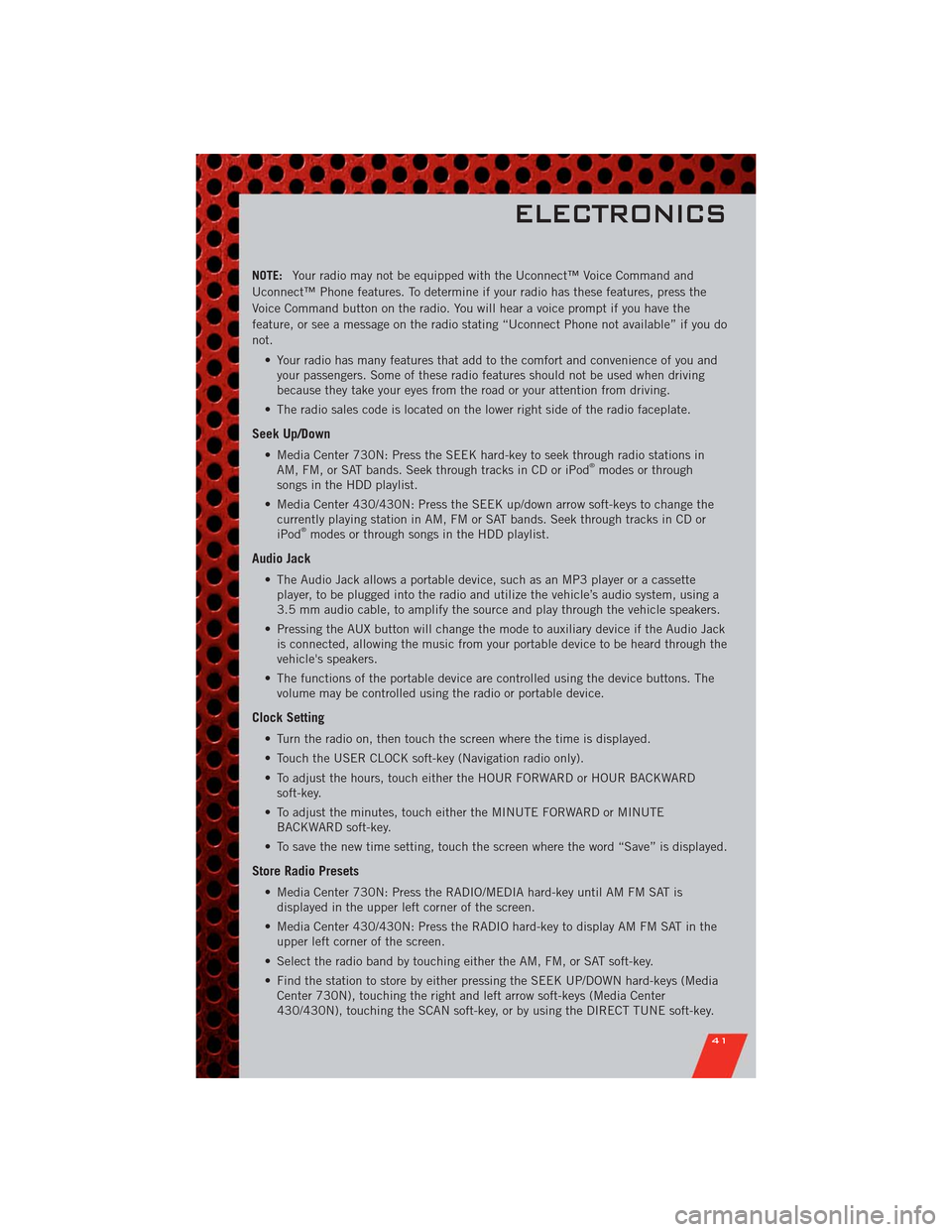
NOTE:Your radio may not be equipped with the Uconnect™ Voice Command and
Uconnect™ Phone features. To determine if your radio has these features, press the
Voice Command button on the radio. You will hear a voice prompt if you have the
feature, or see a message on the radio stating “Uconnect Phone not available” if you do
not.
• Your radio has many features that add to the comfort and convenience of you and
your passengers. Some of these radio features should not be used when driving
because they take your eyes from the road or your attention from driving.
• The radio sales code is located on the lower right side of the radio faceplate.
Seek Up/Down
• Media Center 730N: Press the SEEK hard-key to seek through radio stations in
AM, FM, or SAT bands. Seek through tracks in CD or iPod®modes or through
songs in the HDD playlist.
• Media Center 430/430N: Press the SEEK up/down arrow soft-keys to change the
currently playing station in AM, FM or SAT bands. Seek through tracks in CD or
iPod
®modes or through songs in the HDD playlist.
Audio Jack
• The Audio Jack allows a portable device, such as an MP3 player or a cassette
player, to be plugged into the radio and utilize the vehicle’s audio system, using a
3.5 mm audio cable, to amplify the source and play through the vehicle speakers.
• Pressing the AUX button will change the mode to auxiliary device if the Audio Jack
is connected, allowing the music from your portable device to be heard through the
vehicle's speakers.
• The functions of the portable device are controlled using the device buttons. The
volume may be controlled using the radio or portable device.
Clock Setting
• Turn the radio on, then touch the screen where the time is displayed.
• Touch the USER CLOCK soft-key (Navigation radio only).
• To adjust the hours, touch either the HOUR FORWARD or HOUR BACKWARD
soft-key.
• To adjust the minutes, touch either the MINUTE FORWARD or MINUTE
BACKWARD soft-key.
• To save the new time setting, touch the screen where the word “Save” is displayed.
Store Radio Presets
• Media Center 730N: Press the RADIO/MEDIA hard-key until AM FM SAT is
displayed in the upper left corner of the screen.
• Media Center 430/430N: Press the RADIO hard-key to display AM FM SAT in the
upper left corner of the screen.
• Select the radio band by touching either the AM, FM, or SAT soft-key.
• Find the station to store by either pressing the SEEK UP/DOWN hard-keys (Media
Center 730N), touching the right and left arrow soft-keys (Media Center
430/430N), touching the SCAN soft-key, or by using the DIRECT TUNE soft-key.
ELECTRONICS
41
Page 56 of 108
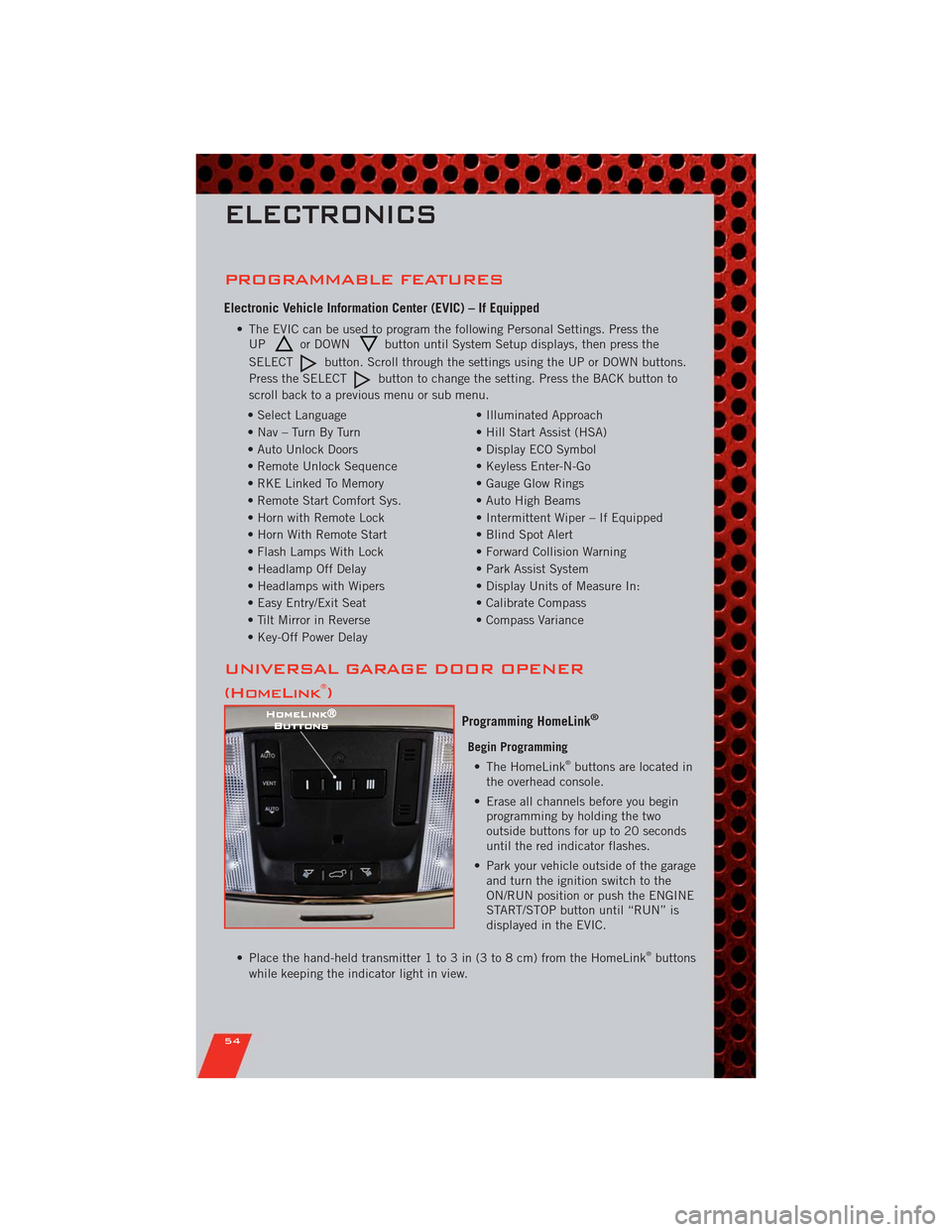
PROGRAMMABLE FEATURES
Electronic Vehicle Information Center (EVIC) – If Equipped
• The EVIC can be used to program the following Personal Settings. Press the
UPor DOWNbutton until System Setup displays, then press the
SELECT
button. Scroll through the settings using the UP or DOWN buttons.
Press the SELECT
button to change the setting. Press the BACK button to
scroll back to a previous menu or sub menu.
• Select Language • Illuminated Approach
• Nav – Turn By Turn • Hill Start Assist (HSA)
• Auto Unlock Doors • Display ECO Symbol
• Remote Unlock Sequence • Keyless Enter-N-Go
• RKE Linked To Memory • Gauge Glow Rings
• Remote Start Comfort Sys. • Auto High Beams
• Horn with Remote Lock • Intermittent Wiper – If Equipped
• Horn With Remote Start • Blind Spot Alert
• Flash Lamps With Lock • Forward Collision Warning
• Headlamp Off Delay • Park Assist System
• Headlamps with Wipers • Display Units of Measure In:
• Easy Entry/Exit Seat • Calibrate Compass
• Tilt Mirror in Reverse • Compass Variance
• Key-Off Power Delay
UNIVERSAL GARAGE DOOR OPENER
(HomeLink®)
Programming HomeLink®
Begin Programming
• The HomeLink®buttons are located in
the overhead console.
• Erase all channels before you begin
programming by holding the two
outside buttons for up to 20 seconds
until the red indicator flashes.
• Park your vehicle outside of the garage
and turn the ignition switch to the
ON/RUN position or push the ENGINE
START/STOP button until “RUN” is
displayed in the EVIC.
• Place the hand-held transmitter 1 to 3 in (3 to 8 cm) from the HomeLink
®buttons
while keeping the indicator light in view.
ELECTRONICS
54
Page 60 of 108
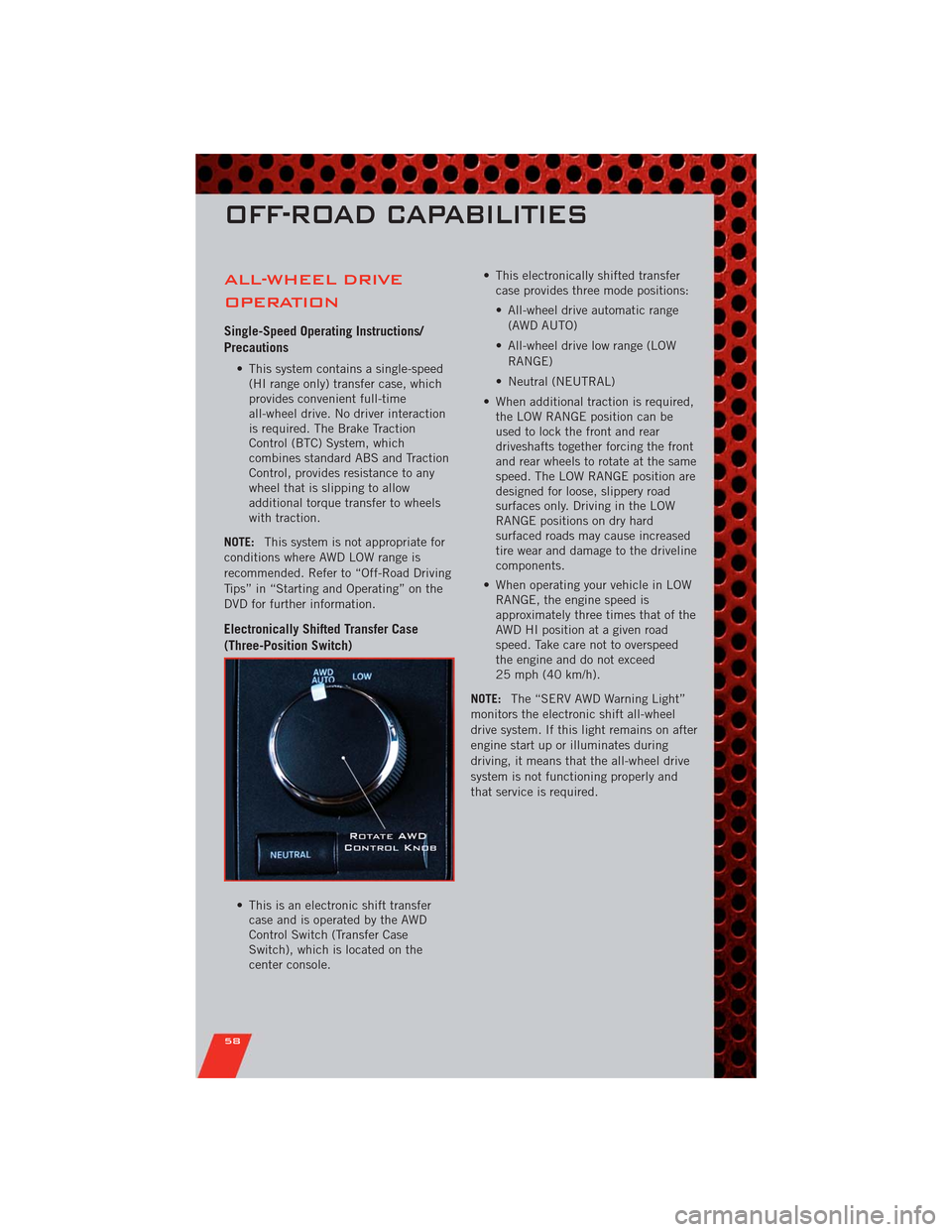
ALL-WHEEL DRIVE
OPERATION
Single-Speed Operating Instructions/
Precautions
• This system contains a single-speed
(HI range only) transfer case, which
provides convenient full-time
all-wheel drive. No driver interaction
is required. The Brake Traction
Control (BTC) System, which
combines standard ABS and Traction
Control, provides resistance to any
wheel that is slipping to allow
additional torque transfer to wheels
with traction.
NOTE:This system is not appropriate for
conditions where AWD LOW range is
recommended. Refer to “Off-Road Driving
Tips” in “Starting and Operating” on the
DVD for further information.
Electronically Shifted Transfer Case
(Three-Position Switch)
• This is an electronic shift transfer
case and is operated by the AWD
Control Switch (Transfer Case
Switch), which is located on the
center console.• This electronically shifted transfer
case provides three mode positions:
• All-wheel drive automatic range
(AWD AUTO)
• All-wheel drive low range (LOW
RANGE)
• Neutral (NEUTRAL)
• When additional traction is required,
the LOW RANGE position can be
used to lock the front and rear
driveshafts together forcing the front
and rear wheels to rotate at the same
speed. The LOW RANGE position are
designed for loose, slippery road
surfaces only. Driving in the LOW
RANGE positions on dry hard
surfaced roads may cause increased
tire wear and damage to the driveline
components.
• When operating your vehicle in LOW
RANGE, the engine speed is
approximately three times that of the
AWD HI position at a given road
speed. Take care not to overspeed
the engine and do not exceed
25 mph (40 km/h).
NOTE:The “SERV AWD Warning Light”
monitors the electronic shift all-wheel
drive system. If this light remains on after
engine start up or illuminates during
driving, it means that the all-wheel drive
system is not functioning properly and
that service is required.
OFF-ROAD CAPABILITIES
58
Page 67 of 108
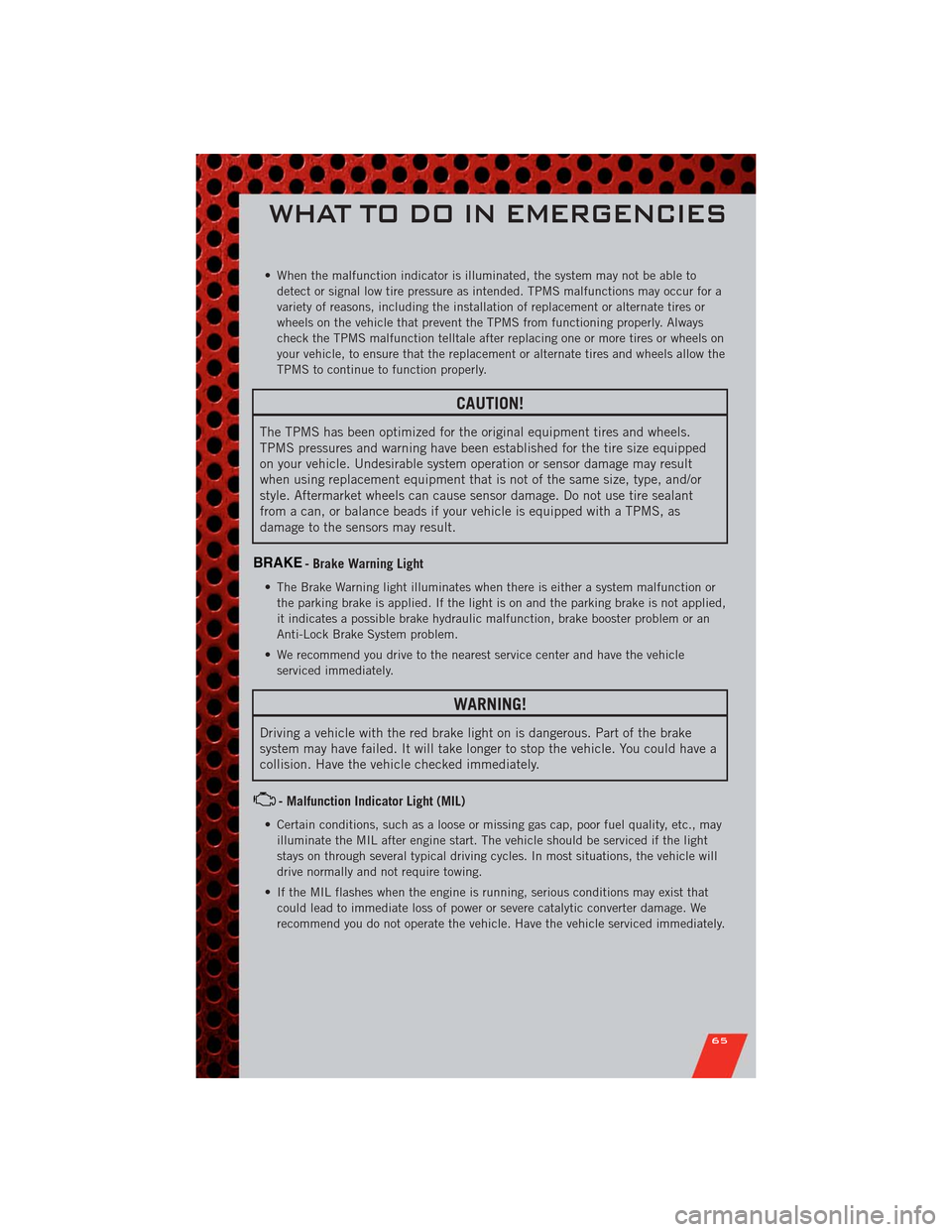
• When the malfunction indicator is illuminated, the system may not be able to
detect or signal low tire pressure as intended. TPMS malfunctions may occur for a
variety of reasons, including the installation of replacement or alternate tires or
wheels on the vehicle that prevent the TPMS from functioning properly. Always
check the TPMS malfunction telltale after replacing one or more tires or wheels on
your vehicle, to ensure that the replacement or alternate tires and wheels allow the
TPMS to continue to function properly.
CAUTION!
The TPMS has been optimized for the original equipment tires and wheels.
TPMS pressures and warning have been established for the tire size equipped
on your vehicle. Undesirable system operation or sensor damage may result
when using replacement equipment that is not of the same size, type, and/or
style. Aftermarket wheels can cause sensor damage. Do not use tire sealant
from a can, or balance beads if your vehicle is equipped with a TPMS, as
damage to the sensors may result.
BRAKE- Brake Warning Light
• The Brake Warning light illuminates when there is either a system malfunction or
the parking brake is applied. If the light is on and the parking brake is not applied,
it indicates a possible brake hydraulic malfunction, brake booster problem or an
Anti-Lock Brake System problem.
• We recommend you drive to the nearest service center and have the vehicle
serviced immediately.
WARNING!
Driving a vehicle with the red brake light on is dangerous. Part of the brake
system may have failed. It will take longer to stop the vehicle. You could have a
collision. Have the vehicle checked immediately.
- Malfunction Indicator Light (MIL)
• Certain conditions, such as a loose or missing gas cap, poor fuel quality, etc., may
illuminate the MIL after engine start. The vehicle should be serviced if the light
stays on through several typical driving cycles. In most situations, the vehicle will
drive normally and not require towing.
• If the MIL flashes when the engine is running, serious conditions may exist that
could lead to immediate loss of power or severe catalytic converter damage. We
recommend you do not operate the vehicle. Have the vehicle serviced immediately.
WHAT TO DO IN EMERGENCIES
65
Page 68 of 108
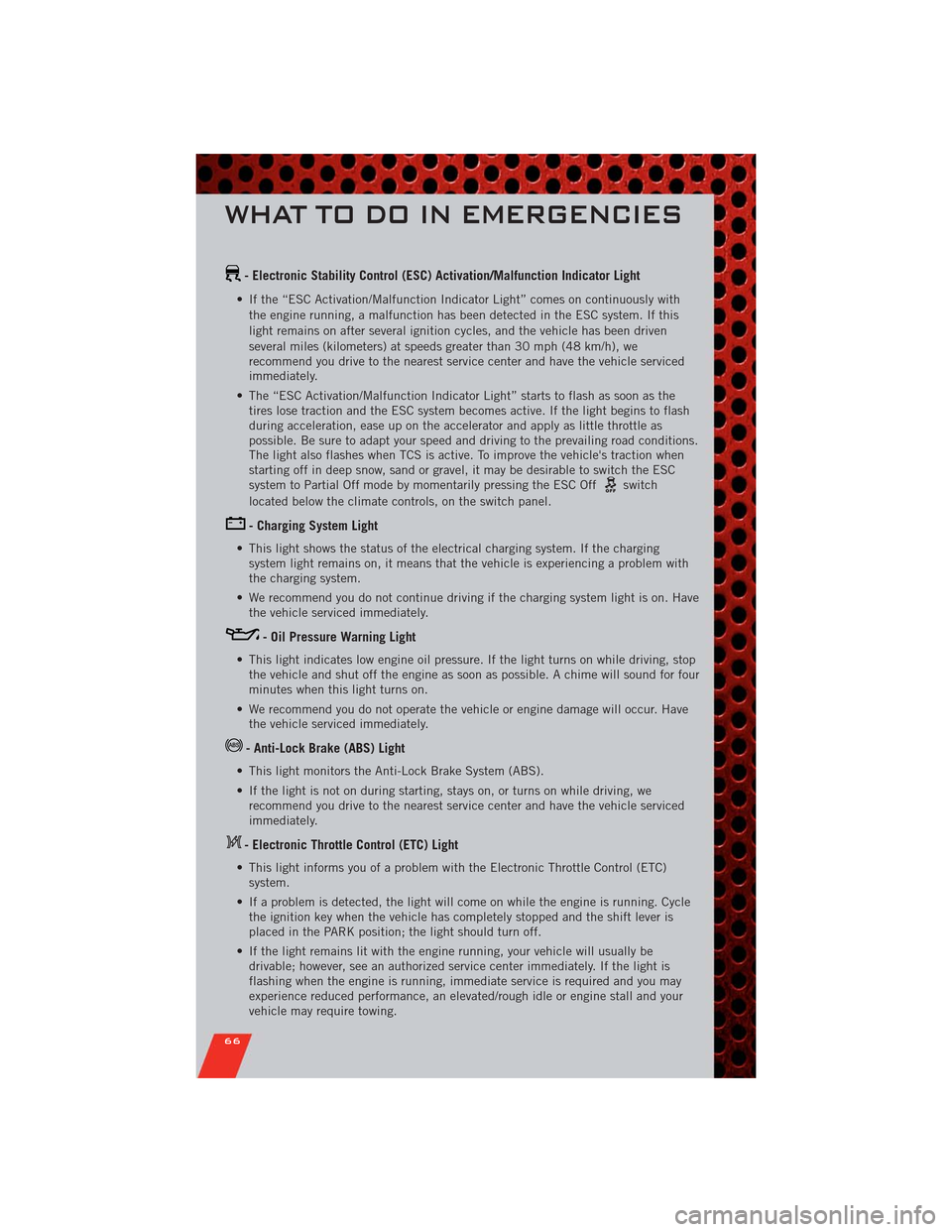
- Electronic Stability Control (ESC) Activation/Malfunction Indicator Light
• If the “ESC Activation/Malfunction Indicator Light” comes on continuously with
the engine running, a malfunction has been detected in the ESC system. If this
light remains on after several ignition cycles, and the vehicle has been driven
several miles (kilometers) at speeds greater than 30 mph (48 km/h), we
recommend you drive to the nearest service center and have the vehicle serviced
immediately.
• The “ESC Activation/Malfunction Indicator Light” starts to flash as soon as the
tires lose traction and the ESC system becomes active. If the light begins to flash
during acceleration, ease up on the accelerator and apply as little throttle as
possible. Be sure to adapt your speed and driving to the prevailing road conditions.
The light also flashes when TCS is active. To improve the vehicle's traction when
starting off in deep snow, sand or gravel, it may be desirable to switch the ESC
system to Partial Off mode by momentarily pressing the ESC Off
switch
located below the climate controls, on the switch panel.
- Charging System Light
• This light shows the status of the electrical charging system. If the charging
system light remains on, it means that the vehicle is experiencing a problem with
the charging system.
• We recommend you do not continue driving if the charging system light is on. Have
the vehicle serviced immediately.
- Oil Pressure Warning Light
• This light indicates low engine oil pressure. If the light turns on while driving, stop
the vehicle and shut off the engine as soon as possible. A chime will sound for four
minutes when this light turns on.
• We recommend you do not operate the vehicle or engine damage will occur. Have
the vehicle serviced immediately.
- Anti-Lock Brake (ABS) Light
• This light monitors the Anti-Lock Brake System (ABS).
• If the light is not on during starting, stays on, or turns on while driving, we
recommend you drive to the nearest service center and have the vehicle serviced
immediately.
- Electronic Throttle Control (ETC) Light
• This light informs you of a problem with the Electronic Throttle Control (ETC)
system.
• If a problem is detected, the light will come on while the engine is running. Cycle
the ignition key when the vehicle has completely stopped and the shift lever is
placed in the PARK position; the light should turn off.
• If the light remains lit with the engine running, your vehicle will usually be
drivable; however, see an authorized service center immediately. If the light is
flashing when the engine is running, immediate service is required and you may
experience reduced performance, an elevated/rough idle or engine stall and your
vehicle may require towing.
WHAT TO DO IN EMERGENCIES
66
Page 69 of 108
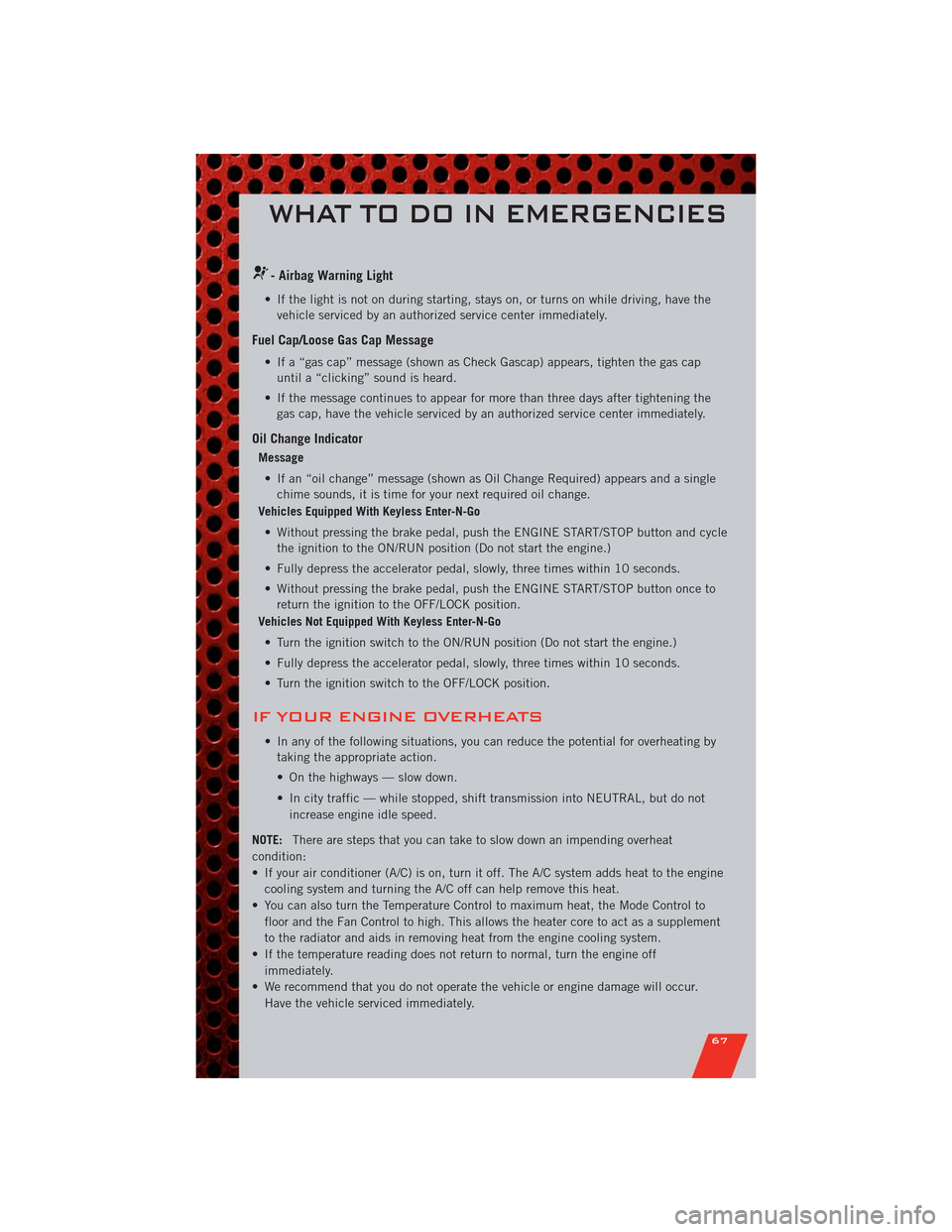
- Airbag Warning Light
• If the light is not on during starting, stays on, or turns on while driving, have the
vehicle serviced by an authorized service center immediately.
Fuel Cap/Loose Gas Cap Message
• If a “gas cap” message (shown as Check Gascap) appears, tighten the gas cap
until a “clicking” sound is heard.
• If the message continues to appear for more than three days after tightening the
gas cap, have the vehicle serviced by an authorized service center immediately.
Oil Change Indicator
Message
• If an “oil change” message (shown as Oil Change Required) appears and a single
chime sounds, it is time for your next required oil change.
Vehicles Equipped With Keyless Enter-N-Go
• Without pressing the brake pedal, push the ENGINE START/STOP button and cycle
the ignition to the ON/RUN position (Do not start the engine.)
• Fully depress the accelerator pedal, slowly, three times within 10 seconds.
• Without pressing the brake pedal, push the ENGINE START/STOP button once to
return the ignition to the OFF/LOCK position.
Vehicles Not Equipped With Keyless Enter-N-Go
• Turn the ignition switch to the ON/RUN position (Do not start the engine.)
• Fully depress the accelerator pedal, slowly, three times within 10 seconds.
• Turn the ignition switch to the OFF/LOCK position.
IF YOUR ENGINE OVERHEATS
• In any of the following situations, you can reduce the potential for overheating by
taking the appropriate action.
• On the highways — slow down.
• In city traffic — while stopped, shift transmission into NEUTRAL, but do not
increase engine idle speed.
NOTE:There are steps that you can take to slow down an impending overheat
condition:
• If your air conditioner (A/C) is on, turn it off. The A/C system adds heat to the engine
cooling system and turning the A/C off can help remove this heat.
• You can also turn the Temperature Control to maximum heat, the Mode Control to
floor and the Fan Control to high. This allows the heater core to act as a supplement
to the radiator and aids in removing heat from the engine cooling system.
• If the temperature reading does not return to normal, turn the engine off
immediately.
• We recommend that you do not operate the vehicle or engine damage will occur.
Have the vehicle serviced immediately.
WHAT TO DO IN EMERGENCIES
67
Page 72 of 108
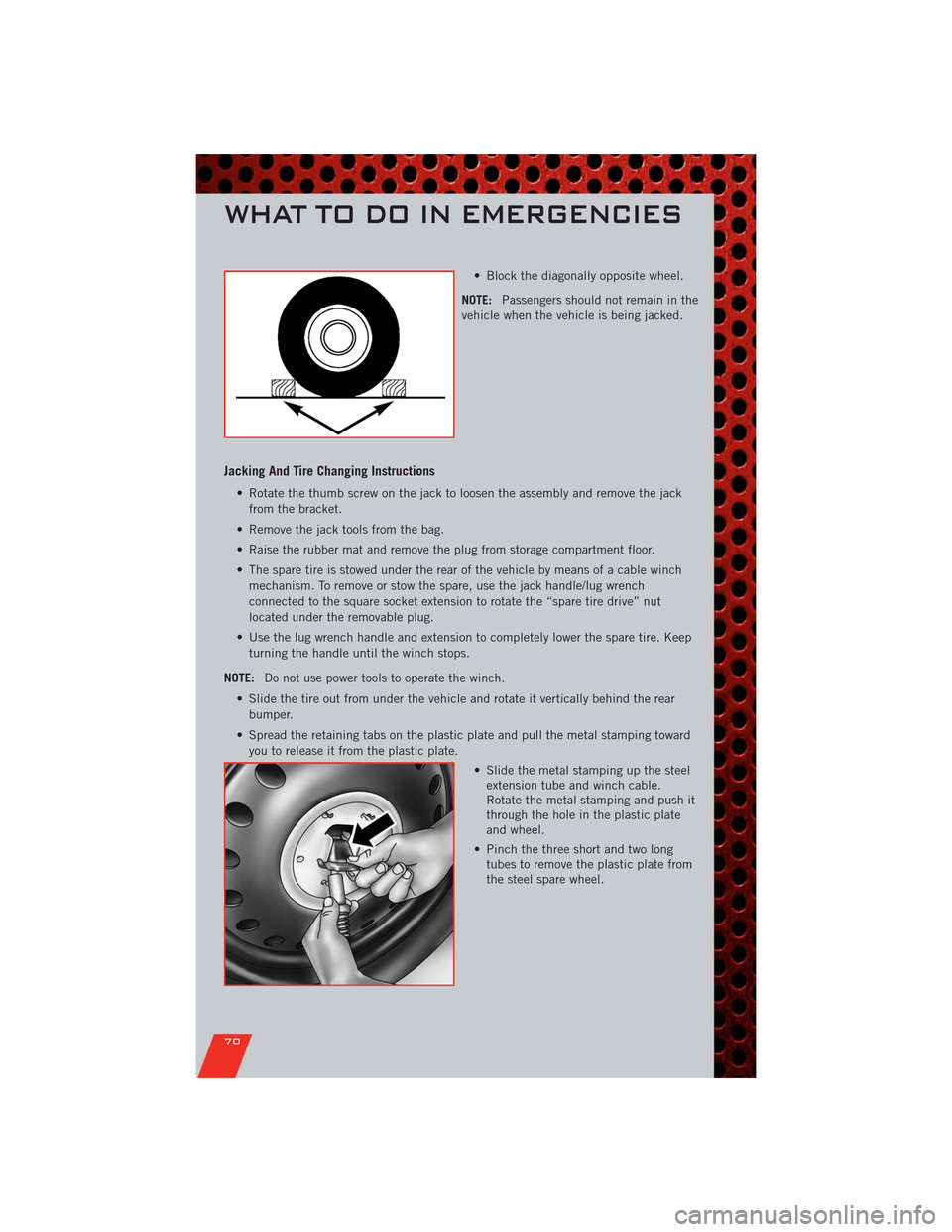
• Block the diagonally opposite wheel.
NOTE:Passengers should not remain in the
vehicle when the vehicle is being jacked.
Jacking And Tire Changing Instructions
• Rotate the thumb screw on the jack to loosen the assembly and remove the jack
from the bracket.
• Remove the jack tools from the bag.
• Raise the rubber mat and remove the plug from storage compartment floor.
• The spare tire is stowed under the rear of the vehicle by means of a cable winch
mechanism. To remove or stow the spare, use the jack handle/lug wrench
connected to the square socket extension to rotate the “spare tire drive” nut
located under the removable plug.
• Use the lug wrench handle and extension to completely lower the spare tire. Keep
turning the handle until the winch stops.
NOTE:Do not use power tools to operate the winch.
• Slide the tire out from under the vehicle and rotate it vertically behind the rear
bumper.
• Spread the retaining tabs on the plastic plate and pull the metal stamping toward
you to release it from the plastic plate.
• Slide the metal stamping up the steel
extension tube and winch cable.
Rotate the metal stamping and push it
through the hole in the plastic plate
and wheel.
• Pinch the three short and two long
tubes to remove the plastic plate from
the steel spare wheel.
WHAT TO DO IN EMERGENCIES
70
Page 73 of 108
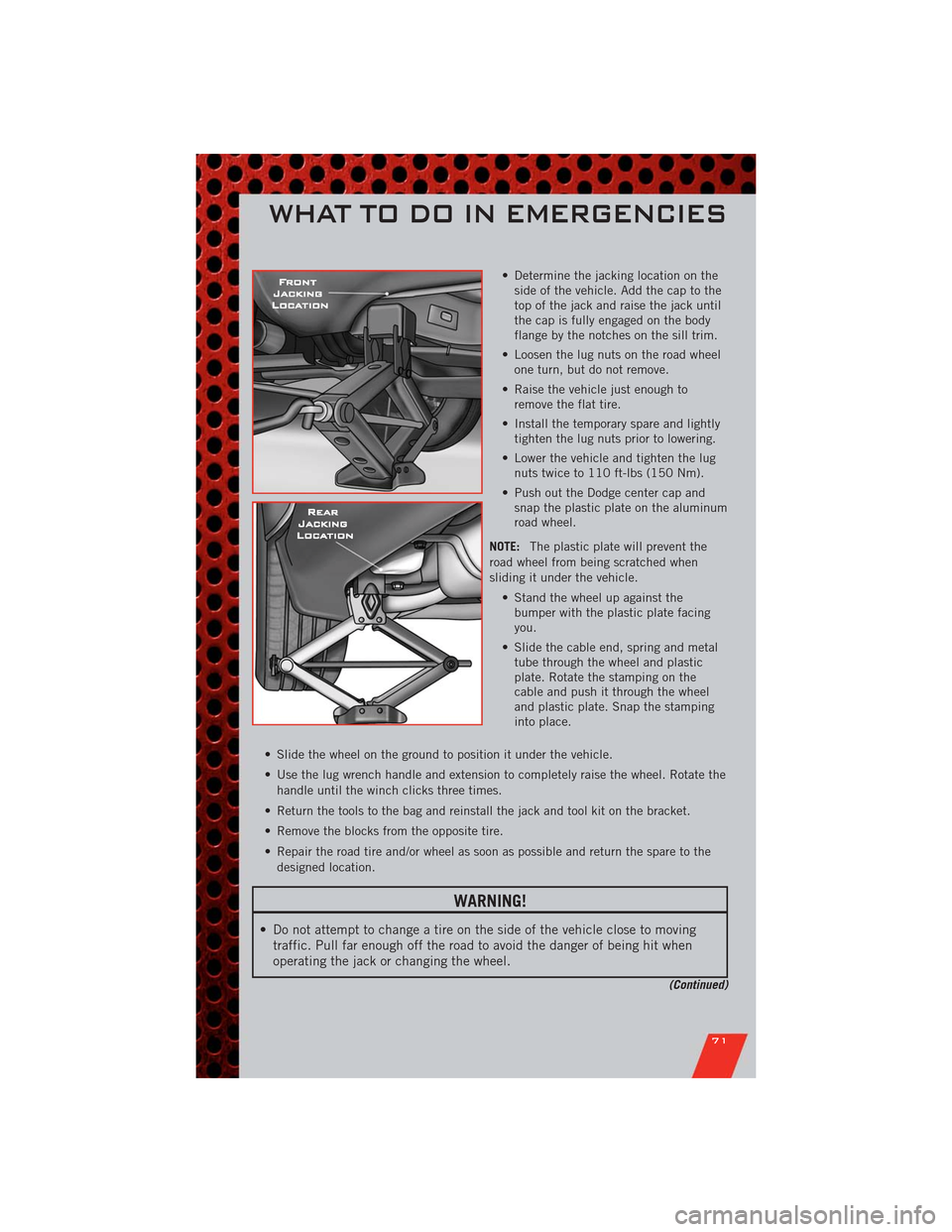
• Determine the jacking location on the
side of the vehicle. Add the cap to the
top of the jack and raise the jack until
the cap is fully engaged on the body
flange by the notches on the sill trim.
• Loosen the lug nuts on the road wheel
one turn, but do not remove.
• Raise the vehicle just enough to
remove the flat tire.
• Install the temporary spare and lightly
tighten the lug nuts prior to lowering.
• Lower the vehicle and tighten the lug
nuts twice to 110 ft-lbs (150 Nm).
• Push out the Dodge center cap and
snap the plastic plate on the aluminum
road wheel.
NOTE:The plastic plate will prevent the
road wheel from being scratched when
sliding it under the vehicle.
• Stand the wheel up against the
bumper with the plastic plate facing
you.
• Slide the cable end, spring and metal
tube through the wheel and plastic
plate. Rotate the stamping on the
cable and push it through the wheel
and plastic plate. Snap the stamping
into place.
• Slide the wheel on the ground to position it under the vehicle.
• Use the lug wrench handle and extension to completely raise the wheel. Rotate the
handle until the winch clicks three times.
• Return the tools to the bag and reinstall the jack and tool kit on the bracket.
• Remove the blocks from the opposite tire.
• Repair the road tire and/or wheel as soon as possible and return the spare to the
designed location.
WARNING!
• Do not attempt to change a tire on the side of the vehicle close to moving
traffic. Pull far enough off the road to avoid the danger of being hit when
operating the jack or changing the wheel.
(Continued)
WHAT TO DO IN EMERGENCIES
71
Page 75 of 108
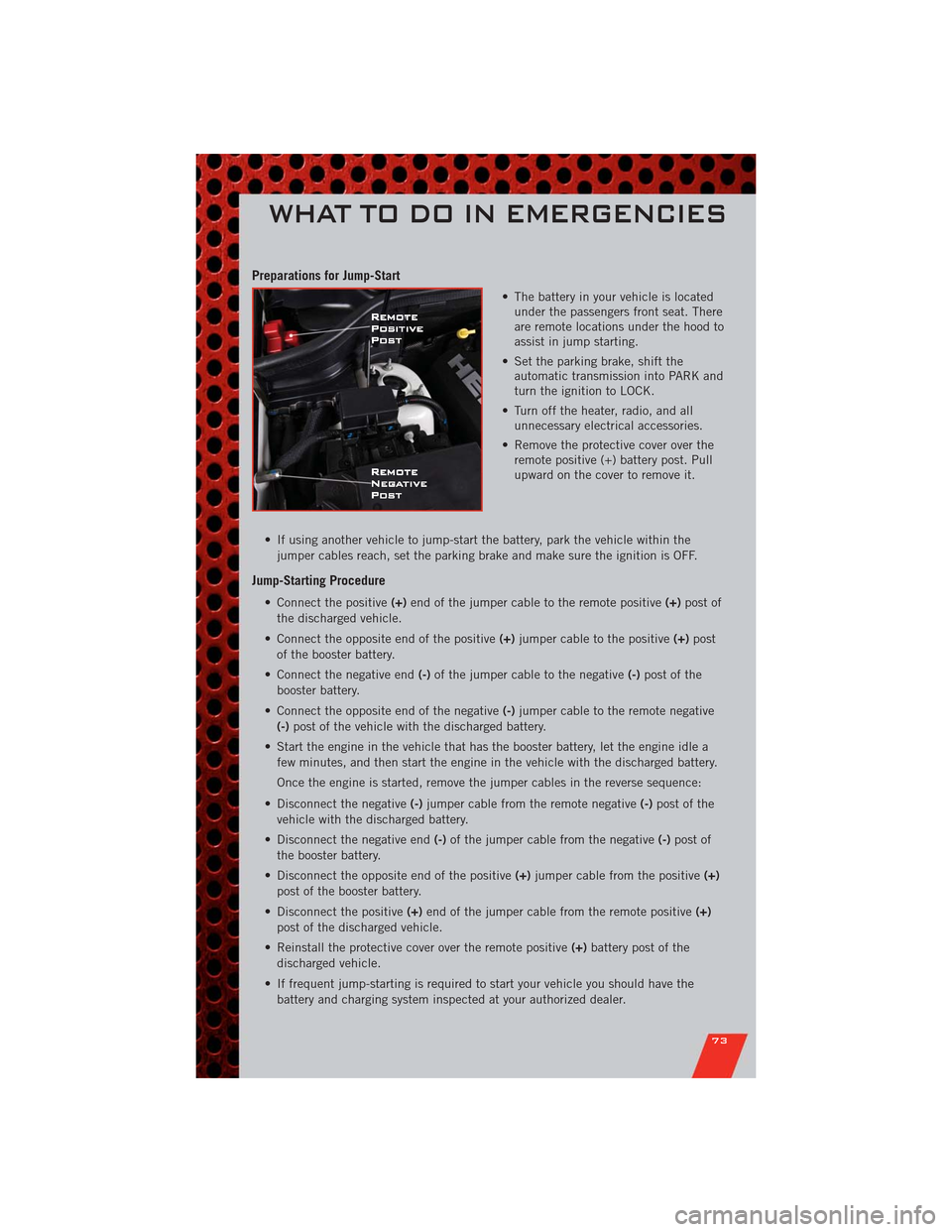
Preparations for Jump-Start
• The battery in your vehicle is located
under the passengers front seat. There
are remote locations under the hood to
assist in jump starting.
• Set the parking brake, shift the
automatic transmission into PARK and
turn the ignition to LOCK.
• Turn off the heater, radio, and all
unnecessary electrical accessories.
• Remove the protective cover over the
remote positive (+) battery post. Pull
upward on the cover to remove it.
• If using another vehicle to jump-start the battery, park the vehicle within the
jumper cables reach, set the parking brake and make sure the ignition is OFF.
Jump-Starting Procedure
• Connect the positive(+)end of the jumper cable to the remote positive(+)post of
the discharged vehicle.
• Connect the opposite end of the positive(+)jumper cable to the positive(+)post
of the booster battery.
• Connect the negative end(-)of the jumper cable to the negative(-)post of the
booster battery.
• Connect the opposite end of the negative(-)jumper cable to the remote negative
(-)post of the vehicle with the discharged battery.
• Start the engine in the vehicle that has the booster battery, let the engine idle a
few minutes, and then start the engine in the vehicle with the discharged battery.
Once the engine is started, remove the jumper cables in the reverse sequence:
• Disconnect the negative(-)jumper cable from the remote negative(-)post of the
vehicle with the discharged battery.
• Disconnect the negative end(-)of the jumper cable from the negative(-)post of
the booster battery.
• Disconnect the opposite end of the positive(+)jumper cable from the positive(+)
post of the booster battery.
• Disconnect the positive(+)end of the jumper cable from the remote positive(+)
post of the discharged vehicle.
• Reinstall the protective cover over the remote positive(+)battery post of the
discharged vehicle.
• If frequent jump-starting is required to start your vehicle you should have the
battery and charging system inspected at your authorized dealer.
WHAT TO DO IN EMERGENCIES
73
Page 80 of 108
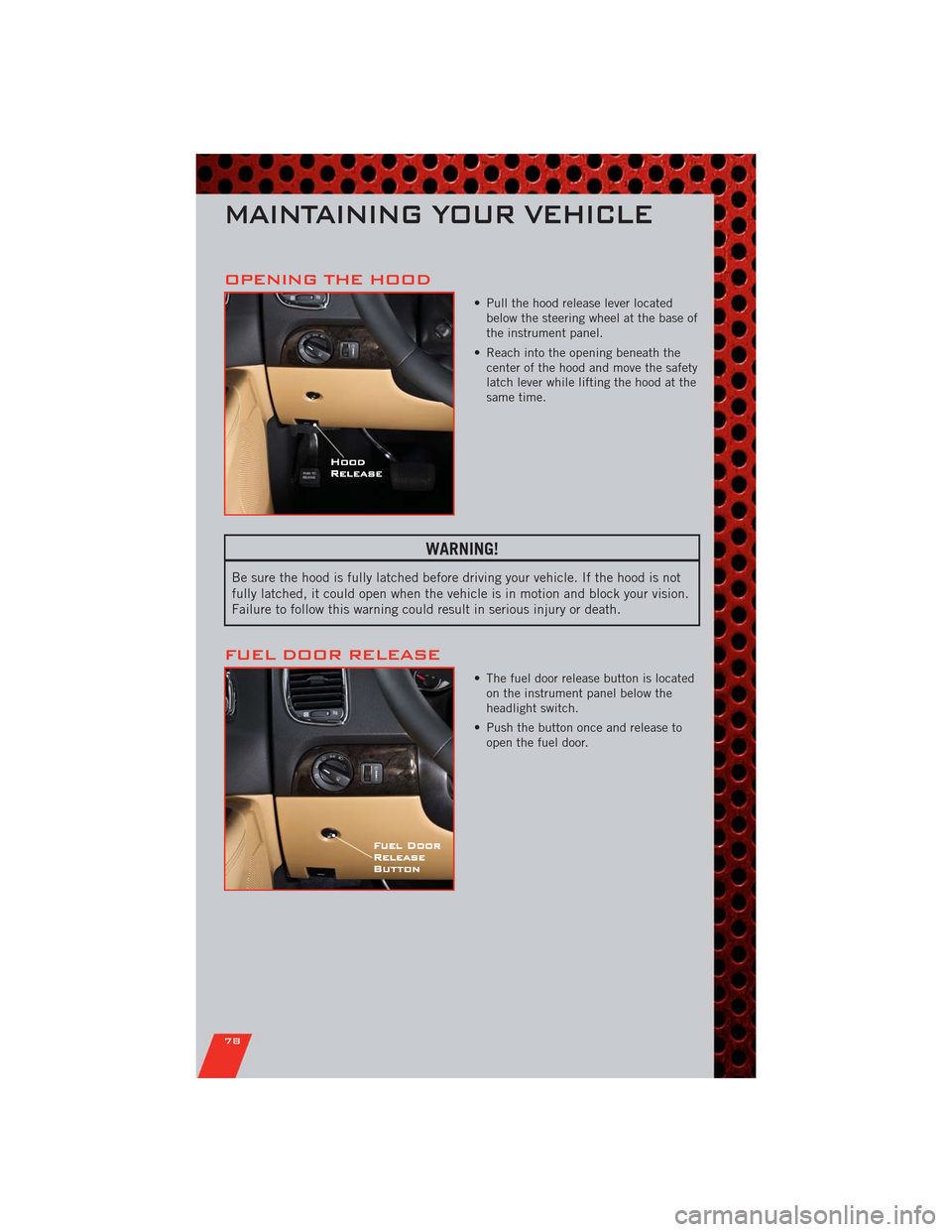
OPENING THE HOOD
• Pull the hood release lever located
below the steering wheel at the base of
the instrument panel.
• Reach into the opening beneath the
center of the hood and move the safety
latch lever while lifting the hood at the
same time.
WARNING!
Be sure the hood is fully latched before driving your vehicle. If the hood is not
fully latched, it could open when the vehicle is in motion and block your vision.
Failure to follow this warning could result in serious injury or death.
FUEL DOOR RELEASE
• The fuel door release button is located
on the instrument panel below the
headlight switch.
• Push the button once and release to
open the fuel door.
MAINTAINING YOUR VEHICLE
78